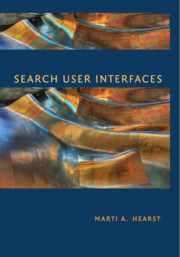Book contents
- Frontmatter
- Contents
- Preface
- 1 The Design of Search User Interfaces
- 2 The Evaluation of Search User Interfaces
- 3 Models of the Information Seeking Process
- 4 Query Specification
- 5 Presentation of Search Results
- 6 Query Reformulation
- 7 Supporting the Search Process
- 8 Integrating Navigation with Search
- 9 Personalization in Search
- 10 Information Visualization for Search Interfaces
- 11 Information Visualization for Text Analysis
- 12 Emerging Trends in Search Interfaces
- Appendix: Additional Copyright Notices
- Bibliography
- Index
- Author Index
- Plate section
10 - Information Visualization for Search Interfaces
Published online by Cambridge University Press: 05 March 2013
- Frontmatter
- Contents
- Preface
- 1 The Design of Search User Interfaces
- 2 The Evaluation of Search User Interfaces
- 3 Models of the Information Seeking Process
- 4 Query Specification
- 5 Presentation of Search Results
- 6 Query Reformulation
- 7 Supporting the Search Process
- 8 Integrating Navigation with Search
- 9 Personalization in Search
- 10 Information Visualization for Search Interfaces
- 11 Information Visualization for Text Analysis
- 12 Emerging Trends in Search Interfaces
- Appendix: Additional Copyright Notices
- Bibliography
- Index
- Author Index
- Plate section
Summary
The preceding chapters have discussed user interfaces to support search, with a focus on what is known to be successful (from a usability perspective) for the vast majority of searchers. This and the following chapter describe efforts to improve search interfaces by incorporating visual information into the display using techniques from the field of information visualization.
The human perceptual system is highly attuned to images, and visual representations can communicate some kinds of information more rapidly and effectively than text. For example, the familiar bar chart or line graph can be much more evocative of the underlying data than the corresponding table of numbers (Larkin and Simon 1987). The goal of information visualization is to translate abstract information into a visual form that provides new insight about that information. Visualization has been shown to be successful at providing insight about data for a wide range of tasks.
The field of information visualization is a vibrant one, with hundreds of innovative ideas burgeoning on the Web. However, applying visualization to textual information is quite challenging, especially when the goal is to improve search over text collections. As discussed in earlier chapters, search is a means towards some other end, rather than a goal in itself. When reading text, one is focused on that task; it is not possible to read and visually perceive something else at the same time. Furthermore, the nature of text makes it difficult to convert it to a visual analog. Most likely for these reasons, applications of visualization to general search have not been widely accepted to date, and few usability results are positive.
- Type
- Chapter
- Information
- Search User Interfaces , pp. 234 - 280Publisher: Cambridge University PressPrint publication year: 2009
- 2
- Cited by



